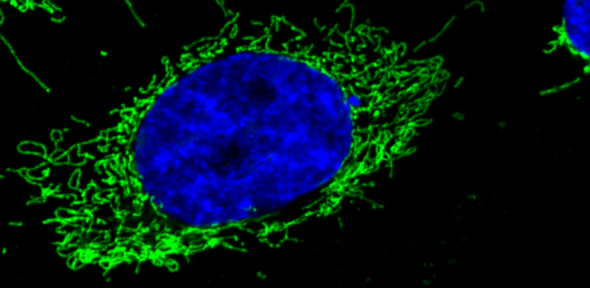
Submitted by Rachel Fellows on Fri, 20/12/2024 - 10:40
Researchers in the MacFarlane lab at the MRC Toxicology Unit have identified that a protein called TAp73 controls mitochondrial function in ciliated cells that line our airways. Ciliated cells are essential to clear mucus from our airways to maintain lung function. As this process is defective in diseases such as Chronic Obstructive Pulmonary Disease (COPD), this new link may help us understand how such conditions develop.
“The TAp73 protein belongs to the p53 family of proteins that have been thoroughly studied for their role in tumour suppression” says first author Dr Niall Buckley. “However, TAp73 is also essential for several processes in embryo development, such as the generation of cells with moving hair-like cilia that line our airways and beat together to remove mucus.”
In mice that had no TAp73, the team found that these ciliated cells were defective. They had altered mitochondrial shape and shorter cilia, which reduces their ability to clear mucus. Buckley adds, “Our study sheds light on the airway functions of TAp73, revealing a new role in regulating mitochondria in ciliated cells.”
Mitochondria are often described as the powerhouse of the cell. These tiny bacteria-derived organelles perform a series of chemical reactions called the electron transport chain that generates energy for the cell in the form of a molecule called ATP. If there is a defect in the mitochondria, this can be disastrous for the cell because it cannot power its many essential functions.
Mitochondria are very dynamic. They can divide (fission), join together (fusion) and create complex networks enabling ATP generation in oxygen poor regions of the cell. Mitochondrial dynamics are key for the health of the cell and are linked to several human genetic disorders. For example, mice or patients with less Optic Atrophy 1 (OPA1) protein have skeletal muscle wasting and damage to the optic nerve, which carries impulses from the eye to the brain. The OPA1 protein is responsible for controlling mitochondrial fusion, mitochondrial membrane folding and electron transport chain function.
In this study, researchers in the MacFarlane lab identified a new role for TAp73 in controlling the switching on of the OPA1 gene. Removing TAp73 in mice resulted in less OPA1 protein and impaired fusion of mitochondria. This had serious consequences for the cell as it reduced its ability to generate energy and resulted in slower growth rates.
Researchers noticed that mice without TAp73 have similar features to patients with COPD, including shortened cilia, impaired ability to clear mucus and altered mitochondrial dynamics. COPD is a complex and progressive lung disease that makes it hard to breathe and is linked to irritants like smoke and pollution, or genetic factors. However, scientists still don’t understand how it develops. The similarity of mice lacking TAp73 with COPD patients, led researchers to investigate if this protein could be involved in progression of the disease. They found that COPD patients have lower expression of OPA1 and the gene which encodes TAp73.
Prof Marion MacFarlane, Group Leader at the Unit and senior author of this study said: “This study provides a new link between loss of TAp73 and OPA1, mitochondrial dysfunction, impaired mucus clearance and the development of diseases like COPD.” This discovery could help scientists develop better treatments for COPD which affects millions of people worldwide.
'TAp73 regulates mitochondrial dynamics and multiciliated cell homeostasis through an OPA1 axis' was published in Cell Death and Disease on 8th November 2024. See the full article here.


